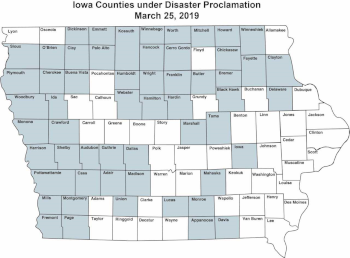
| March 2019 | |||||||||||
| Top stories | |||||||||||
| In the news | |||||||||||
| Photos | |||||||||||
| Contact us | |||||||||||
| Archive | |||||||||||
|
Disaster proclamation increases to 56 counties |
March 26, 2019 --
More than half of Iowa counties are under disaster proclamation due to flooding in the Midwest that began in mid-March, causing Iowa, Nebraska and Wisconsin to declare states of emergency.

Gov. Kim Reynolds announced on March 25 that Chickasaw, Hamilton and Mitchell counties have been added to the list of counties with disaster proclamations, bringing the latest total to 56.
The floods came in the aftermath of a “bomb cyclone,” a weather phenomenon with a drastic drop in air pressure that caused blizzard conditions and heavy rainfall on frozen ground.
Approximately 10 percent of Iowans use a private well for drinking water. Flooding can compromise a well and potentially contaminate the water. Nancy Hall, SHL manager of Environmental Microbiology, said that the SHL is ready to respond with testing, guidance and consultations.
“All three SHL locations (Coralville, Ankeny and Lakeside) are ready to send out sample containers and receive samples, especially for the bacteria analysis to evaluate the sanitary quality of the drinking water,” Hall said.
“Regarding inundated private wells, it is imperative as the IDNR flood fact sheet states, to 1) not drink or wash with the well water; 2) not attempt to work on the well system (because of the danger of electrical shock), and instead contact a certified well contractor; and 3) not test the drinking water until after the waters have receded and the well system has been flushed and shock chlorinated,” Hall said.
Hall recommends that private well owners contact their local public health department “for their expertise in sampling, guidance and funding (for free analyses) for this testing. Unfortunately, with the extensive flooding in our western counties, I anticipate SHL will be receiving a lot more well water samples for testing in about a month or so when, hopefully for those impacted, recovery measures have started. SHL has been and always will be ready to respond when called upon.”
Additional resources to guide private well flood recovery are available on the SHL website.